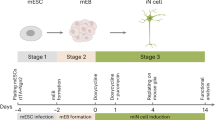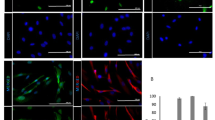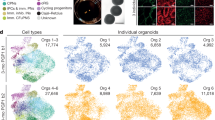Abstract
It is now possible to grow stem cells from a wide variety of tissues. Some of these cells have been shown to differentiate into presumptive neurons in vitro, or after transplantation into the developing or adult brain. When stem cells derived directly from the brain are induced to differentiate, there is a high probability that some of the resulting cells will be neurons. However, when stem cells from one tissue (for example, bone marrow or skin) take on the phenotype of another (for example, brain), rigorous criteria are required to define neurons. The aim of this review is to discuss the various techniques that are used to identify a cell as a neuron.
This is a preview of subscription content, access via your institution
Access options
Subscribe to this journal
Receive 12 print issues and online access
$189.00 per year
only $15.75 per issue
Buy this article
- Purchase on Springer Link
- Instant access to full article PDF
Prices may be subject to local taxes which are calculated during checkout



Similar content being viewed by others
References
Bjorklund, A. & Svendsen, C. N. Chimeric stem cells. Trends Mol. Med. 7, 144–146 (2001).
Anderson, D. J., Gage, F. H. & Weissman, I. L. Can stem cells cross lineage boundaries? Nature Med. 7, 393–395 (2001).
Orkin, S. H. Stem cell alchemy. Nature Med. 6, 1212–1213 (2000).
Cajal, R. S. Recollections of My Life (translated by E. H. Craigie with the assistance of J. Cano) (Am. Phil. Soc., Philadelphia, 1937; reprinted by MIT Press, Cambridge, Massachusetts, 1989).
Raff, M. C., Miller, R. H. & Noble, M. A glial progenitor cell that develops in vitro into an astrocyte or an oligodendrocyte depending on the culture medium. Nature 303, 390–396 (1983).
Zhang, S.-C. Defining glial cells during CNS development. Nature Rev. Neurosci. 2, 840–843 (2001).
Diez del Corral, R. & Storey, K. G. Markers in vertebrate neurogenesis. Nature Rev. Neurosci. 2, 835–839 (2001).
Garcia-Verdugo, J. M., Doetsch, F., Wichterle, H., Lim, D. A. & Alvarez-Buylla, A. Architecture and cell types of the adult subventricular zone: in search of the stem cells. J. Neurobiol. 36, 234–248 (1998).
Rakic, P. Guidance of neurons migrating to the fetal monkey neocortex. Brain Res. 33, 471–476 (1971).
Lois, C. & Alvarez-Buylla, A. Long-distance neuronal migration in the adult mammalian brain. Science 264, 1145–1148 (1994).
Luskin, M. B., Zigova, T., Soteres, B. J. & Stewart, R. R. Neuronal progenitor cells derived from the anterior subventricular zone of the neonatal rat forebrain continue to proliferate in vitro and express a neuronal phenotype. Mol. Cell. Neurosci. 8, 351–366 (1997).
Katsetos, C. D. et al. Aberrant localization of the neuronal class III β-tubulin in astrocytomas. Arch. Pathol. Lab. Med. 125, 613–624 (2001).
Sensenbrenner, M., Lucas, M. & Deloulme, J. C. Expression of two neuronal markers, growth-associated protein 43 and neuron-specific enolase, in rat glial cells. J. Mol. Med. 75, 653–663 (1997).
Rosser, A. E., Tyers, P., Ter Borg, M., Dunnett, S. B. & Svendsen, C. N. Co-expression of MAP-2 and GFAP in cells developing from rat EGF responsive precursor cells. Brain Res. Dev. Brain Res. 98, 291–295 (1997).
Mullen, R. J., Buck, C. R. & Smith, A. M. NeuN, a neuronal specific nuclear protein in vertebrates. Development 116, 201–211 (1992).
Woodbury, D., Schwarz, E. J., Prockop, D. J. & Black, I. B. Adult rat and human bone marrow stromal cells differentiate into neurons. J. Neurosci. Res. 61, 364–370 (2000).
Doetsch, F., Caille, I., Lim, D. A., Garcia-Verdugo, J. M. & Alvarez-Buylla, A. Subventricular zone astrocytes are neural stem cells in the adult mammalian brain. Cell 97, 703–716 (1999).
Toma, J. G. et al. Isolation of multipotent adult stem cells from the dermis of mammalian skin. Nature Cell Biol. 3, 778–784 (2001).
Onifer, S. M., White, L. A., Whittemore, S. R. & Holets, V. R. In vitro labeling strategies for identifying primary neural tissue and a neuronal cell line after transplantation. Cell Transplant. 2, 131–149 (1993).
Craig, C. G. et al. In vivo growth factor expansion of endogenous subependymal neural precursor cell populations in the adult mouse brain. J. Neurosci. 16, 2649–2658 (1996).
Kuhn, H. G., Winkler, J., Kempermann, G., Thal, L. J. & Gage, F. H. Epidermal growth factor and fibroblast growth factor-2 have different effects on neural progenitors in the adult rat brain. J. Neurosci. 17, 5820–5829 (1997).
Brazelton, T. R., Rossi, F. M., Keshet, G. I. & Blau, H. M. From marrow to brain: expression of neuronal phenotypes in adult mice. Science 290, 1775–1779 (2000).
Mezey, E. & Chandross, K. J. Bone marrow: a possible alternative source of cells in the adult nervous system. Eur. J. Pharmacol. 405, 297–302 (2000).
Magavi, S. S., Leavitt, B. R. & Macklis, J. D. Induction of neurogenesis in the neocortex of adult mice. Nature 405, 951–955 (2000).
Li, Y., Chen, J., Wang, L., Lu, M. & Chopp, M. Treatment of stroke in rat with intracarotid administration of marrow stromal cells. Neurology 56, 1666–1672 (2001).
Huneeus, F. C. & Davison, P. F. Fibrillar proteins from squid axons. I. Neurofilament protein. J. Mol. Biol. 52, 415–428 (1970).
Viereck, C., Tucker, R. P., Binder, L. I. & Matus, A. Phylogenetic conservation of brain microtubule-associated proteins MAP2 and tau. Neuroscience 26, 893–904 (1988).
Wiedenmann, B. & Franke, W. W. Identification and localization of synaptophysin, an integral membrane glycoprotein of Mr 38,000 characteristic of presynaptic vesicles. Cell 41, 1017–1028 (1985).
Caccamo, D. et al. Immunohistochemistry of a spontaneous murine ovarian teratoma with neuroepithelial differentiation. Neuron-associated β-tubulin as a marker for primitive neuroepithelium. Lab. Invest. 60, 390–398 (1989).
Matus, A. Microtubule-associated proteins: their potential role in determining neuronal morphology. Annu. Rev. Neurosci. 11, 29–44 (1988).
Schmechel, D., Marangos, P. J. & Brightman, M. Neurone-specific enolase is a molecular marker for peripheral and central neuroendocrine cells. Nature 276, 834–836 (1978).
Garner, C. C., Brugg, B. & Matus, A. A 70-kilodalton microtubule-associated protein (MAP2c), related to MAP2. J. Neurochem. 50, 609–615 (1988).
Marusich, M. F. & Weston, J. A. Identification of early neurogenic cells in the neural crest lineage. Dev. Biol. 149, 295–306 (1992).
Author information
Authors and Affiliations
Corresponding author
Related links
Related links
DATABASES
FURTHER INFORMATION
Rights and permissions
About this article
Cite this article
Svendsen, C., Bhattacharyya, A. & Tai, YT. Neurons from stem cells: preventing an identity crisis. Nat Rev Neurosci 2, 831–834 (2001). https://doi.org/10.1038/35097581
Issue Date:
DOI: https://doi.org/10.1038/35097581
This article is cited by
-
Dopamine neuron induction and the neuroprotective effects of thyroid hormone derivatives
Scientific Reports (2019)
-
The protein phosphatase activity of PTEN is essential for regulating neural stem cell differentiation
Molecular Brain (2015)
-
Recent therapeutic strategies for spinal cord injury treatment: possible role of stem cells
Neurosurgical Review (2012)
-
Disease Targets and Strategies for the Therapeutic Modulation of Endogenous Neural Stem and Progenitor Cells
Clinical Pharmacology & Therapeutics (2007)
-
Expression of NMDA receptors in multipotent stromal cells of human adipose tissue under conditions of retinoic acid-induced differentiation
Bulletin of Experimental Biology and Medicine (2007)



